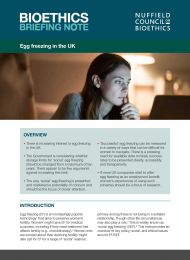Egg freezing in the UK
Policy Briefing
Published 30/09/2020

Egg freezing (EF) is an increasingly popular technology that aims to preserve women’s fertility. Women* might have EF for medical purposes, including if they need treatment that affects fertility (e.g., chemotherapy). Women who are worried about their declining fertility might also opt for EF for a range of ‘social’ reasons: primary among these is not being in a suitable relationship, though other life circumstances may also play a role. This is widely known as ‘social egg freezing’ (SEF).** This note provides an overview of key policy, social, and ethical issues around EF/SEF.
*For the purposes of this discussion, we use the term ‘women’ to include anyone who might want to freeze their eggs, regardless of their gender identity.
**This term has been criticised as judgmental, but similar terms – e.g., lifestyle EF – also have drawbacks.
A full list of references can be accessed by downloading the briefing note.
Box 1. Example egg freezing cycle
- For around 12 days, self-administered injections of hormones stimulate egg production in the ovaries, aiming to:
- Stabilise the womb lining;
- Prevent ovulation when it would usually happen; and
- Stimulate the ovaries to produce multiple large follicles (which contain eggs).
- Vaginal ultrasounds confirm growth/size of follicles.
- Once follicles are large enough, an injection is given to trigger maturation.
- 36 hours later, mature eggs are collected from the follicles under sedation.
- The eggs are frozen in liquid nitrogen.
Thawing, implanting, pregnancy, live birth
- When a woman wants to use her eggs, they are thawed.
- Eggs that survive thawing are fertilised through intracytoplasmic sperm injection (ICSI), which injects sperm directly into the egg.
- If embryos develop, 1-2 are transferred to the womb, ideally around day 5, with the aim of achieving a pregnancy and live birth.

Share